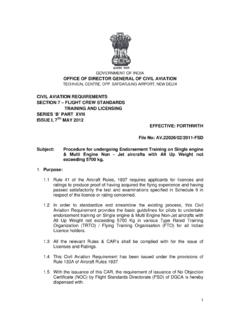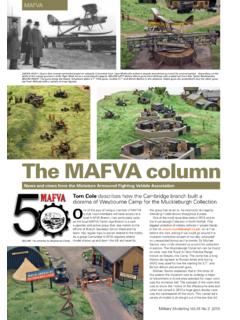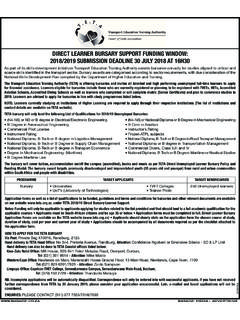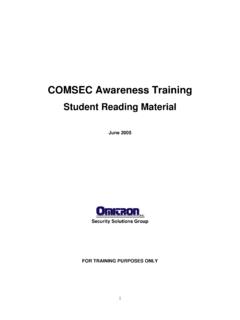Transcription of BY ORDER OF THE COMMANDER AIR EDUCATION …
1 BY ORDER OF THE COMMANDER AIR EDUCATION AND TRAINING COMMAND (AETC) AIR EDUCATION AND TRAINING COMMAND INSTRUCTION 36-2909 10 JULY 2017 Personnel RECRUITING, EDUCATION , ACCESSIONS, AND TRAINING STANDARDS OF CONDUCT COMPLIANCE WITH THIS PUBLICATION IS MANDATORY ACCESSIBILITY: This publication is available for downloading or ordering on the e- Publishing website at RELEASABILITY: There are no releasability restrictions on this publication. OPR: AETC/JA Supersedes: AETCI 36-2909, Recruiting, EDUCATION , and Training Standards of Conduct, 2 December 2013 Certified by: HQ AETC/JA (Col Polly S. Kenny) Pages: 37 This instruction implements AFI 36-2909, Professional and Unprofessional Relationships, with an emphasis on recruiting, accessions, training, and EDUCATION environments.
2 It applies to the following individuals assigned or attached to Air EDUCATION and Training Command (AETC) units or participating in AETC-sponsored training or EDUCATION programs as instructors, staff, trainees, cadets, or students: all active duty members and members of the United States Air Force Reserve (USAFR) and Air National Guard (ANG); Department of Defense (DoD) civilians; Air Force Reserve Officer Training Corps (AFROTC) and Total Force Officer Training (TFOT) cadets; Commissioned Officer Training (COT) and Reserve Commissioned Officer Training (RCOT) Officer Trainees (OT); international military or civilian personnel; and contractor personnel. Finally, it applies to recruiting personnel and Airmen who participate in the Recruiter Assistance Program (RAP).
3 Failure to observe prohibitions and mandatory provisions of this instruction in paragraphs , , , or (or any subparagraphs thereunder) by military personnel is a violation of Article 92 of the Uniform Code of Military Justice (UCMJ) as well as any other applicable article of the UCMJ. Civilian personnel who violate prohibitions or mandatory provisions of paragraphs , , , or (or any subparagraphs thereunder) of this instruction are subject to disciplinary or adverse action under AFI 36-704, Discipline and Adverse Actions, and civilian criminal or civil sanction. Contractor personnel who violate any prohibition or mandatory provision of this instruction are subject to penalties according to local 2 AETCI36-2909 10 JULY 2017 laws and the terms of the governing contract.
4 Ensure that all records created as a result of processes prescribed in this publication are maintained in accordance with AFMAN 33-363, Management of Records, and disposed of in accordance with the Air Force Records Information Management System (AFRIMS) Records Disposition Schedule (RDS). Refer recommended changes and questions about this publication to the Office of Primary Responsibility (OPR) using Air Force Form 847, Recommendation for Change of Publication; route AF Forms 847 from the field through the appropriate functional chain of command. The authorities to waive wing/unit level requirements in this publication are identified with a Tier ( T-0, T-1, T-2, T-3 ) number following the compliance statement.
5 Submit requests for waivers through the chain of command to the appropriate Tier waiver approval authority, or, alternately, to the Publication OPR, HQ AETC/JAM, for non-tiered compliance items. Attachment 1 contains a glossary of references and supporting information. SUMMARY OF CHANGES This document has been substantially revised and must be completely reviewed. Major changes include articulation of Foundational Principles, definition and role of Mission-Area ACommanders, and revision of guidance on professional and unprofessional relationships to reflect Department of Defense regulations and varied Air EDUCATION and Training Command operational environments.
6 Chapter 1 BACKGROUND 4 Foundational Principles.. 4 Personnel and Activities Subject to This Instruction.. 4 Recruiting, EDUCATION , Accessions, and Training Oversight Council.. 7 Mission-Area COMMANDER .. 7 Direct-Report Group COMMANDER .. 8 Waivers.. 8 Chapter 2 GENERAL GUIDELINES 10 Responsibilities.. 10 Reporting Alleged Misconduct.. 10 Disposition of Alleged Misconduct.. 13 Personnel Information File.. 14 Contractor 14 Previous Versions of AETCI 36-2909 .. 15 AETCI Training Requirements.. 15 AETCI36-2909 10 JULY 2017 3 Chapter 3 PROFESSIONAL AND UNPROFESSIONAL RELATIONSHIPS 17 Overview of Professional Relationships.. 17 Overview of Unprofessional Relationships.. 17 General Guidance on Relationships.
7 17 Communication for Official and Professional Purposes.. 18 Pre-Existing Relationships .. 18 Informal Professional Interaction, Mentoring, and 19 Direct Training Relationships.. 19 Specific Prohibitions and Responsibilities.. 19 Professional Relationships in Other AETC Programs .. 22 Reporting and Documenting Unprofessional Relationships.. 24 Chapter 4 EDUCATION AND TRAINING ABUSE AND HAZING 25 Overview.. 25 EDUCATION and Training Abuse and Hazing.. 25 25 Cruelty and Maltreatment.. 26 Hazing.. 27 Reporting of Allegations .. 28 Documentation and Accountability Actions .. 28 Chapter 5 ACADEMIC INTEGRITY 29 Overview.. 29 Terms Explained.. 29 Academic Integrity Violation.
8 29 Responsibilities.. 30 Consequences of Violations.. 30 Reporting of Violations.. 31 Documentation of Violations.. 31 Attachment 1 GLOSSARY OF REFERENCES AND SUPPORTING INFORMATION 32 4 AETCI36-2909 10 JULY 2017 Chapter 1 BACKGROUND Foundational Principles. America s respect and esteem for the Profession of Arms and trust in the United States Air Force make Air Force service an honor and privilege. The Oaths of Enlistment, Commissioning, and Civil Service; Air Force Core Values; and Airman s Creed contain the foundational principles of Air Force service. Each Airman s daily adherence to Air Force standards of conduct reinforces these principles. Every Airman has a duty to act professionally, protect America s honor, and preserve the confidence of the American public.
9 Living by the highest standards of conduct and integrity and pledging to safeguard the dignity, respect, and well-being of all wingmen enables the Air Force to fly, fight, and win in air, space, and cyberspace. Air EDUCATION and Training Command (AETC) Airmen have the opportunity and responsibility to reinforce AETC s trust with the American public, the larger Air Force, and other branches of the armed forces every time a recruit is accessed, a trainee is given foundational skills, or a student is educated. All Airmen assigned to AETC organizations must demonstrate an unwavering commitment to upholding standards of conduct; protecting applicants, recruits, trainees, cadets, and students; and accomplishing the mission.
10 This instruction recognizes that, in general, applicants, recruits, trainees, cadets, and students occupy unique positions within the Air Force and AETC. When entering into the Air Force or any culture individuals are motivated to maintain the esteem of their leaders and membership in the organization. This environment can deter individuals from expressing legitimate complaints against abuses of power and authority. This instruction guards against inappropriate interactions in AETC s recruiting, EDUCATION , accessions, and training environments. This instruction also recognizes that unprofessional relationships within AETC may engender actual or perceived bias.
















